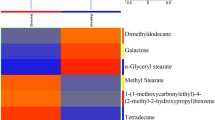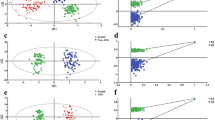Abstract
Colorectal cancer (CRC) is mainly depended on the radical operation, the changing energy metabolism after operation reflects the extent, the magnitude, and the degree of surgical trauma. The aim of this study was to analyse the biochemical perturbation in the serum of CRC after operation and to evaluate their involvement in the progression of CRC. Gas chromatograph-mass spectrometry (GC-MS) in combination with pattern recognition techniques (Partial least squares discriminant analysis, supervised clustering analysis) was used to analyze serum metabolome in 30 CRC patients. A 34 endogenous metabolites included amino acid, fatty acid, carbohydrate and other intermediate metabolites were identified. Partial least squares discriminant analysis based on these metabolites discriminated preoperative from postoperative CRC group. Compared with preoperative CRC patients group, decreases in l-valine, 5-oxo-l-proline, 1-deoxyglucose, d-turanose, d-maltose, arachidonic acid and hexadecanoic acid levels and increases in l-tyrosine levels were observed in postoperative CRC patients group. The result demonstrated the GC-MS technique is an valuable tool for the characterization of the metabolic perturbation, and the metabolomic study will certainly benefit for monitoring the nutrition state of CRC patients, the prognosis and therapy evaluation of CRC patients after operation.




Similar content being viewed by others
Abbreviations
- CRC:
-
Colorectal cancer
- PLS-DA:
-
Partial least squares discriminant analysis
- GC-MS:
-
Gas chromatography-mass spectrometry
- TIC:
-
Total ion current
- LMC:
-
Low molecular weight compounds
- MVDA:
-
Multivariate data analysis
- MSTFA:
-
Trimethylsilyl-trifluoroacetamide
- DM:
-
Diabetes mellitus
- HL:
-
Hyperlipoidemia
- TMCS:
-
Trimethylchlorosilane
References
Ward DG, Suggett N, Cheng Y, Wei W, Johnson H, Billingham LJ, Ismail T, Wakelam MJ, Johnson PJ, Martin A (2006) Identification of serum biomarkers for colon cancer by proteomic analysis. Br J Cancer 94:1898–1905. doi:10.1038/sj.bjc.6603188
Hung KE, Chung DC (2006) Colorectal cancer screening: today and tomorrow. South Med J 99:240–246. doi:10.1097/01.smj.0000203817.89741.29
Tan S, Seow TK, Liang RC, Koh S, Lee CP, Chung MC, Hooi SC (2002) Proteome analysis of butyrate-treated human colon cancer cells (HT-29). Int J Cancer 98:523–531. doi:10.1002/ijc.10236
You WC, Jin F, Devesa S, Gridley G, Schatzkin A, Yang G, Rosenberg P, Xiang YB, Hu YR, Li Q (2002) Rapid increase in colorectal cancer rates in urban Shanghai, 1972–97, in relation to dietary changes. J Cancer Epidemiol Prev 7:143–146
Denkert C, Budczies J, Weichert W, Wohlgemuth G, Scholz M, Kind T, Niesporek S, Noske A, Buckendahl A, Dietel M, Fiehn O (2008) Metabolite profiling of human colon carcinoma–deregulation of TCA cycle and amino acid turnover. Mol Cancer 7:72. doi:10.1186/1476-4598-7-72
Chan EC, Koh PK, Mal M, Cheah PY, Eu KW, Backshall A, Cavill R, Nicholson JK, Keun HC (2008) Metabolic profiling of human colorectal cancer using high-resolution magic angle spinning nuclear magnetic resonance (HR-MAS NMR) spectroscopy and gas chromatography mass spectrometry (GC/MS). J Proteome Res. (Epub ahead of print)
Seierstad T, Røe K, Sitter B, Halgunset J, Flatmark K, Ree AH, Olsen DR, Gribbestad IS, Bathen TF (2008) Principal component analysis for the comparison of metabolic profiles from human rectal cancer biopsies and colorectal xenografts using high-resolution magic angle spinning 1H magnetic resonance spectroscopy. Mol Cancer 7:33. doi:10.1186/1476-4598-7-33
Pasikanti KK, Ho PC, Chan EC (2008) Gas chromatography/mass spectrometry in metabolic profiling of biological fluids. J Chromatogr B Analyt Technol Biomed Life Sci 871:202–211. doi:10.1016/j.jchromb.2008.04.033
Sato N, Kusama A, Ohkawa A, Koyama Y, Oyamatsu M, Kayama S, Yoshikawa K, Tanaka O, Muto K (1993) Resting energy expenditure in patients undergoing transhiatal or transthoracic oesophagectomy for carcinoma of the thoracic oesophagus. Br J Surg 80:1413–1415. doi:10.1002/bjs.1800801119
Chernow B, Alexander HR, Smallridge RC, Thompson WR, Cook D, Beardsley D, Fink MP, Lake CR, Fletcher JR (1987) Hormonal responses to graded surgical stress. Arch Intern Med 147:1273–1278. doi:10.1001/archinte.147.7.1273
Brandi LS, Bertolini R, Janni A, Gioia A, Angeletti CA (1996) Energy metabolism of thoracic surgical patients in the early postoperative period. Effect of posture. Chest 109:630–637. doi:10.1378/chest.109.3.630
Feng B, Zheng MH, Zheng YF, Lu AG, Li JW, Wang ML, Ma JJ, Xu GW, Liu BY, Zhu ZG (2005) Normal and modified urinary nucleosides represent novel biomarkers for colorectal cancer diagnosis and surgery monitoring. J Gastroenterol Hepatol 20:1913–1919. doi:10.1111/j.1440-1746.2005.03888.x
Saghatelian A, Cravatt BF (2005) Global strategies to integrate the proteome and metabolome. Curr Opin Chem Biol 9:62–68. doi:10.1016/j.cbpa.2004.12.004
Griffin JL (2006) Understanding mouse models of disease through metabolomics. Curr Opin Chem Biol 10:111–117. doi:10.1016/j.cbpa.2006.06.027
Nobeli I, Thornton JM (2006) A bioinformatician’s view of the metabolome. Bioessays 28:534–545. doi:10.1002/bies.20414
Nicholson JK, Lindon JC, Holmes E (1999) ‘Metabonomics’: understanding the metabolic responses of living systems to pathophysiological stimuli via multivariate statistical analysis of biological NMR spectroscopic data. Xenobiotica 29:1181–1189. doi:10.1080/004982599238047
Nicholson JK, Connelly J, Lindon JC, Holmes E (2002) Metabonomics: a platform for studying drug toxicity and gene function. Nat Rev Drug Discov 1:153–161. doi:10.1038/nrd728
Shen Q, Li X, Qiu Y, Su M, Liu Y, Li H, Wang X, Zou X, Yan C, Yu L, Li S, He L, Jia W (2008) Metabonomic and metallomic profiling in the amniotic fluid of malnourished pregnant rats. J Proteome Res. (Epub ahead of print)
Tang HR, Wang YL (2006) Metabonomics: a revolution in progress. Prog Biochem Biophys 33:401–417
Lindon JC, Holmes E, Bollard ME, Stanley EG, Nicholson JK (2004) Metabonomics technologies and their applications in physiological monitoring, drug safety assessment and disease diagnosis. Biomarkers 9:1–31. doi:10.1080/13547500410001668379
Mao YY, Bai JQ, Chen JH, Shou ZF, He Q, Wu JY, Chen Y, Cheng YY (2008) A pilot study of GC/MS-based serum metabolic profiling of acute rejection in renal transplantation. Transpl Immunol 19:74–80
Jiye A, Trygg J, Gullberg J, Johansson AI, Jonsson P, Antti H, Marklund SL, Moritz T (2005) Extraction and GC/MS analysis of the human blood plasma metabolome. Anal Chem 77:8086–8094. doi:10.1021/ac051211v
Jonsson P, Gullberg J, Nordstrom A, Kusano M, Kowalczyk M, Sjostrom M, Moritz T (2004) A strategy for in large series of metabolomic samples analyzed by GC/MS. Anal Chem 76:1738–1745. doi:10.1021/ac0352427
Jonsson P, Johansson AI, Gullberg J, Trygg J, Jiye A, Grung B, Marklund S, Sjosttrom M, Antti H, Moritz T (2005) High-throughput data analysis for detecting and identifying differences between samples in GC/MS-based metabolomic analyses. Anal Chem 77:5635–5642. doi:10.1021/ac050601e
Kim YS, Maruvada P, Milner JA (2008) Metabolomics in biomarker discovery: future uses for cancer prevention. Future Oncol 4:93–102. doi:10.2217/14796694.4.1.93
Langbein S, Zerilli M, Zur Hausen A, Staiger W, Rensch-Boschert K, Lukan N, Popa J, Ternullo MP, Steidler A, Weiss C, Grobholz R, Willeke F, Alken P, Stassi G, Schubert P, Coy JF (2006) Expression of transketolase TKTL1 predicts colon and urothelial cancer patient survival: Warburg effect reinterpreted. Br J Cancer 94:578–585. doi:10.1038/sj.bjc.6602962
Yu K, Sheng G, Sheng J, Chen Y, Xu W, Liu X, Cao H, Cheng Y, Li L (2007) A metabonomic investigation on the biochemical perturbation in liver failure patients caused by hepatitis B virus. J Proteome Res 6:2413–2419. doi:10.1021/pr060591d
Jonsson P, Bruce SJ, Moritz T, Trygg J, Sjostrom M, Plumb R, Granger J, Maibaum E, Nicholson JK, Holmes E, Antti H (2005) Extraction, interpretation and validation of information for comparing samples in metabolic LC/MS data sets. Analyst (Lond) 130:701–707. doi:10.1039/b501890k
den Broeder E, Oeseburg B, Lippens RJ, van Staveren WA, Sengers RC, van′s Hof MA, Tolboom JJ (2001) Basal metabolic rate in children with a solid tumour. Eur J Clin Nutr 55:673–681. doi:10.1038/sj.ejcn.1601199
Fredrix EW, Staal-van den Brekel AJ, Wouters EF (1997) Energy balance in nonsmall cell lung carcinoma patients before and after surgical resection of their tumors. Cancer 79:717–723. doi:10.1002/(SICI)1097-0142(19970215)79:4<717::AID-CNCR8>3.0.CO;2-A
Fredrix EW, Soeters PB, von Meyenfeldt MF, Saris WH (1991) Resting energy expenditure in cancer patients before and after gastrointestinal surgery. J Parenter Enter Nutr 15:604–607. doi:10.1177/0148607191015006604
Hansell DT, Davies JW, Burns HJ (1986) Effects of hepatic metastases on resting energy expenditure in patients with colorectal cancer. Br J Surg 73:659–662. doi:10.1002/bjs.1800730828
Zarkovic M, Beleslin B, Ciric J, Penezic Z, Stojkovic M, Trbojevic B, Drezgic M, Savic S (2008) Glucocorticoid effect on insulin sensitivity: a time frame. J Endocrinol Invest 31:238–242
Barth E, Albuszies G, Baumgart K, Matejovic M, Wachter U, Vogt J, Radermacher P, Calzia E (2007) Glucose metabolism and catecholamines. Crit Care Med 35:508–518. doi:10.1097/01.CCM.0000278047.06965.20
Simopoulos AP (1999) Essential fatty acids in health and chronic disease. J Clin Nutr 70:560–569
Burr GO, Burr MM, Miller E (1930) On the nature and role of the fatty acids essential in nutrition. J Biol Chem 86:587
Acknowledgments
We would like to express our deep and sincere gratitude to the Professor M. Michael Wolf (Boston University School of Medicine, USA) for his advice on this manuscript when he came to Shanghai. We thank Professor Harry Hua-Xiang Xia (Department of Medicine, The University of Hong Kong, Queen Mary Hospital, Hong Kong SAR) for help suggestion in preparation of the revised manuscript. This study was financially supported by the Grants from Shanghai Science and Technology Development Fund (No. 05DJ14010), the Major Basic Research Program of Shanghai (No. 07DZ19505), and the Ministry of Science and Technology of People’s Republic of China (No. 2008CB517403).
Competing interests
We declare that we have no competing interests.
Author information
Authors and Affiliations
Corresponding author
Additional information
Authors’ contributions
Professor Huanlong Qin designed the total experiment; Dr Weijie Liu, Jiayuan Peng and Long Huang collected the colorectal cancer serum samples; Yanlei Ma, Xiaoping Zhao and Yiyu Cheng performed the entire study, meanwhile, analyzed and interpreted the acquired data; Yanlei Ma wrote the manuscript, Professor Huanlong Qin decided to submit the manuscript for publication.
Rights and permissions
About this article
Cite this article
Ma, Y., Liu, W., Peng, J. et al. A pilot study of gas chromatograph/mass spectrometry-based serum metabolic profiling of colorectal cancer after operation. Mol Biol Rep 37, 1403–1411 (2010). https://doi.org/10.1007/s11033-009-9524-4
Received:
Accepted:
Published:
Issue Date:
DOI: https://doi.org/10.1007/s11033-009-9524-4




